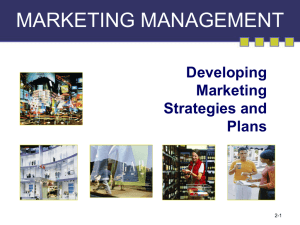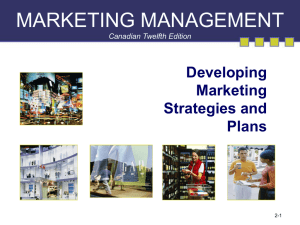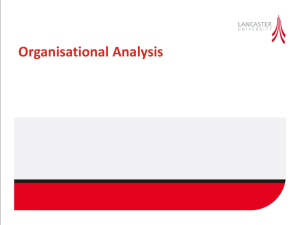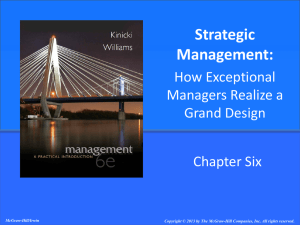Topic 2 - Analysing internal and external environment Update
advertisement
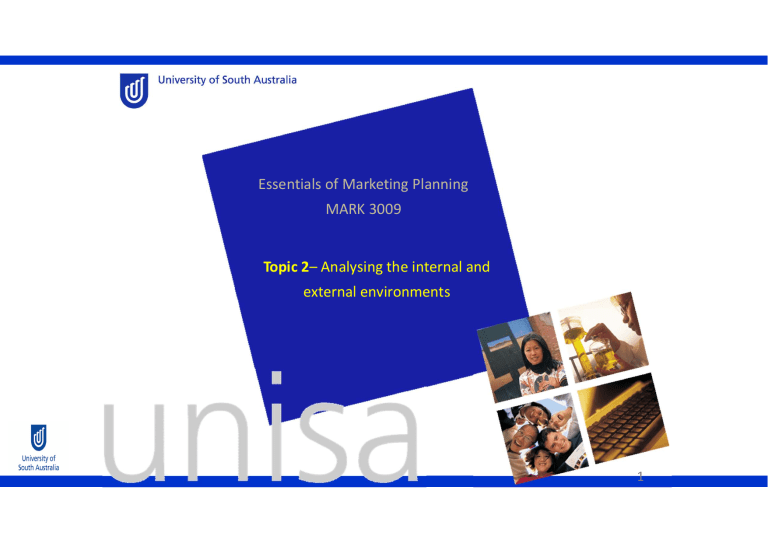
Essentials of Marketing Planning MARK 3009 Topic 2– Analysing the internal and external environments 1 Reminder: A marketing planning process 2 “Know thy self, know thy enemy. A thousand battles, a thousand victories” Sun Tzu: Chinese General & Strategist 544-496 BC 3 Topics 1. Analysing internal situation • BCG matrix • GE/McKinsey Grid • RBV (Resource-based View) 2. Analysing external environment • SWOT and environmental scanning • Porter’s 5-forces model • Competitor analysis 4 How to manage the portfolio in a firm? • Synergy of strategic business Units • Resource allocation • Investment management • Balance in revenue 5 BCG Matrix • Created by Mr. Bruce Henderson in Boston Consulting Group (BCG) in 1968 • One of the most famous tools of portfolio analysis • To manage strategic business units (SBUs) or product lines • To make investment decision • To guide marketing strategy development in each SBU Desired path BCG Matrix Death path Investment flow Revenue: + + + Investment: - Balance: + Revenue: + Investment: - - Balance: - • Portfolio analysis • Investment management Revenue: + + + Investment: 0 Balance: +++ Revenue: + Investment: Balance: 0 • Marketing strategy development An example: Samsung Balancing the business portfolio Hooley et al (2020) marketing strategy & competitive positioning (7e) Fig 2.5 BCG matrix Useful for planning and strategy involving companies with a portfolio of different products, business units Simplistic e.g., assumes that cash flow is more important than return of investment (ROI) Assumes relative market share and growth rate are the only factors affecting cash flow. GE (General Electric) Grid Also called GE/McKinsey Grid Market Attractiveness, e.g.: market size, industry profit margin, amount of competition, seasonality of demand, energy requirements and industry cost structure Competitive Strength, e.g. : price competitiveness, product quality, unit costs, customer and market knowledge, sales effectiveness, distribution network, customer satisfaction, brand reputation, and geographical advantages You choose the criteria, and their relative weights, and their scores. GE Grid: General Electric/McKinsey Grid Market Attractiveness New market entry Improve position Invest to grow Improve position Protect position Invest to grow Protect position Optimise position Improve position Harvest Optimise position Improve position Invest to grow Optimise position Improve position Harvest Divest Monetize Harvest Divest Monetize Harvest Divest Competitive Strength = Offensive strategy = Defensive strategy 12 An example: GE Grid for Office Star Industry Attractiveness • Overall market size Office supplies Furniture Computers Software Ink & Toner Marketing weights Finance weights Product Fit 4 4 3 2 5 5 3 Brand Reputation 5 3 2 1 4 5 2 Market Share 3 2 1 3 3 3 5 Competitive Advantage 4 5 3 2 3 5 1 Business Strength • Annual growth rate Business Strength: • Product fit • Brand reputation • Marketing share • Competitive advantage Vertical Axis (ratings, weights) • Competitive intensity • Historical margins On a scale from 1 to 5, rate Products on each factor, and weight the importance of each factor. Industry Attractiveness Office supplies Furniture Computers Software Ink & Toner Marketing weights Finance weights Overall Market Size 4 4 5 3 2 2 5 Annual Market Growth Rate 1 2 4 3 4 2 4 Competitive Intensity 2 4 5 2 2 4 2 Historial Margins 2 2 1 3 4 3 5 Market Size On a scale from 1 to 20, please enter market size for each item. Office supplies Furniture Computers Software Ink & Toner 8 6 8 9 5 Market Size Source: Lilien et at (2003) Marketing Engineering An example: GE Grid for Office Star Topics Why can some companies outperform others in a competitive market? 1. Analysing internal situation • BCG matrix • GE/McKinsey Grid • RBV (Resource-based View) 2. Analysing external environment • SWOT and environmental scanning • Porter’s 5-forces model • Competitor analysis © Richard Lee, School of Marketing 15 Resource-based View (RBV) : Barney 1991 Resources: • Valuable (created to customers) • Rare • Inimitable (not easily be copied by rivals) • Organised (wisely used) RBV: Barney, Jay 1991). "Firm Resources and Sustained Competitive Advantage". Journal of Management. 17 (1): 99–120. Hooley et al (2020) marketing strategy & competitive positioning (7e) Fig 6.3 16 RBV: Foundation behind sustainable competitiveness Can Bunnings Warehouse open its stores in China? RBV: Foundation behind sustainable competitiveness • High power distance culture • DIY is not valued in China • Products are made in China • Prevalence of materialism • Availability of local cheap labours • Different life style in China Resource-based View (RBV) Marketing assets • Market share • Brand awareness • Customer loyalty • Unique selling point (USP) • Firm’s reputation • Support from business partners Hooley et al (2020) marketing strategy & competitive positioning (7e) Fig 6.5 19 1. Analysing internal environment • BCG matrix • GE/McKinsey Grid • RBV 2. Analysing external environment • SWOT and environmental scanning • Porter’s 5-forces model • Competitor analysis 20 Topics 1. Analysing internal environment • BCG matrix • GE/McKinsey Grid • RBV 2. Analysing external environment • SWOT and environmental scanning (PEST analysis) • Porter’s 5-forces model • Competitor analysis © Richard Lee, School of Marketing 21 SWOT and environmental scanning External Internal SWOT Analysis It comprises two fundamental areas of analysis, the Internal (S&W) and External (O&T) Environment. It helps us to identify where strategies are required to pursue opportunities and defend against threats. One of the most misused tool in marketing and business planning. SWOT analysis: Definition S: Internal capabilities/factors that may help in • achieving objectives; • addressing opportunities; • deflecting competition, other threats. W: Internal capabilities/factors that may prevent firm from • achieving objectives; • making the most of opportunities; • addressing competition, other threats. O: External circumstances/factors that may be exploited for higher performance T: External circumstances/factors that may inhibit performance if not addressed SWOT strategic implications Hooley et al (2020) marketing strategy & competitive positioning (7e) Fig 2.9 An example: SWOT analysis of Starbucks Source: Euromonitor (Through “ Passport” in UniSA Library database ) External environment – PEST factors External environment – PEST factors • • • • Political (instability, leadership, law and regulations) Economic (recession or recovery, buying power) Social–cultural (demographics, attitudes, perceptions) Technological (innovation, standards, marketing uses) Political (instability, leadership, law and regulations) External environment – PEST factors External environment – PEST factors • • • • • • • • • Political (instability, leadership, law and regulations) Economic (recession or recovery, buying power) Social–cultural (demographics, attitudes, perceptions) Technological (innovation, standards, marketing uses) Increase in living cost Appreciation in Australian dollar Inefficiency in production Increase in labour costs Competition in Australian car market Global chocolate confectionary: challenges, opportunities and risks • Sales of chocolate still predominantly stem from Western markets • Chocolate remains the snacks of the wealthy • Value growth has been spectacular in India and China (25% and 7% CAGRs, respectively) and steady in Western markets (3% and 2% CAGRs in the US and the UK, respectively). • India & China will be the largest emerging markets for chocolate • Australian market is stagnant Source: Euromonitor (Through “ Passport” in UniSA Library database ) GLOBAL OVERVIEW Consumption slowdown but opportunities in Middle East and Asia • Per capital consumption is declining in the Western European and the US • Opportunities come from Middle East and Asia • Consumers are now more wary of the adverse health affects of excessive consumption Source: Euromonitor (Through “ Passport” in UniSA Library database ) External environment – PEST factors • • • • Political (instability, leadership, law and regulations) Economic (recession or recovery, buying power) Social–cultural (demographics, attitudes, perceptions) Technological (innovation, standards, marketing uses) Expressions of Culture - Values • Value influences the way people perceive the meaning of life and how to pursue happiness; • Value serves as a norm to guide behaviours and • Value provides the predisposition to judge what is An example: Diversity in marriage • Romantic v pragmatic • Egalitarianism v hierarchy • Polygamous v sole loyalty (a husband could have up to 4 wives in some countries) • Sexual behaviour before marriage • Legitimacy of Same-sex marriage • Who pays for the house and fees of wedding ceremony (must buy a house to set a family in China) • Legitimacy of same sex marriage (should girls get married before 28 ?) • Taboos in marriage (No wedding in the year of the sheep in China) An example: IKEA removed the image of women from its catalogue in Middle East The picture in the catalogue in Sweden (L) The picture in the catalogue in Saudi Arabia (R) An example: IKEA Post in Denmark v China • The room is smaller • The room is bigger • One child policy • Brother & sister • Go higher! • Enjoy freedom • Long term orientation • Equality • High power distance • Books on the self • Have fun! • Indulgence The picture in the IKEA catalogue in Denmark (L) vs Shanghai (R). Climbing, jumping and balancing can develop intelligence of children Source: Case Study 7.2 :Hollensen (2014) Global Marketing 6th Edition pp266 External environment – PEST factors • • • • Political (instability, leadership, law and regulations) Economic (recession or recovery, buying power) Social–cultural (demographics, attitudes, perceptions) Technological (innovation, standards, marketing uses) External environment – PEST factors • • • • Political (instability, leadership, law and regulations) Economic (recession or recovery, buying power) Social–cultural (demographics, attitudes, perceptions) Technological (innovation, standards, marketing uses) External environment – Environmental factors External environment – PEST factors https://i0.wp.com/www.business-to-you.com/wp-content/uploads/2016/09/PESTEL.jpg External environment – Political & Economic factors Political factors Economic factors • • • • • • Economic growth rate • Interest rate • Inflation rate • Exchange rate • Availability of credit • Level of disposable income • Propensity of people to spend • Federal government budget deficits • Gross domestic product trend • Unemployment trend • Stock market trends • Price fluctuations • Degree of urbanisation • • • • • • • • • • • • • Government stability/instability Corruption level Tax policies Freedom of press Government regulation and deregulation Special tariffs Political action committees Government involvement in trade unions and agreements Competition regulation Voter participation rates Amount of government protests Defence expenditures Level of government subsidies Bilateral relationships Import-export regulation/restrictions Trade control Lobbying activities Size of government budgets Source: https://www.business-to-you.com/scanning-the-environment-pestel-analysis/ Source: https://www.business-to-you.com/scanning-the-environment-pestel-analysis/ External environment – Societal and Technical factors Societal factors • Population size and growth rate • Birth rates • Death rates • Number of marriages • Number of divorces • Immigration and emigration rates • Life expectancy rates • Age distribution • Wealth distribution • Social classes • Family size and structure • Lifestyles • Health consciousness • Average disposable income • Attitude towards government • Attitude towards work • Buying habits • Ethical concerns • Cultural norms and values • Sex roles and distribution • Religion and beliefs • Racial equality • Use of birth control • Education level Technical factors • Technology incentives • Automation • R&D activity • Technological change • Access to new technology • Level of innovation • Technological awareness • Internet infrastructure • Communication infrastructure • Life cycle of technology Source: https://www.business-to-you.com/scanning-the-environment-pestel-analysis/ Source: https://www.business-to-you.com/scanning-the-environment-pestel-analysis/ External environment – PESTLE Environmental factors • Weather • Climate • Environmental policies • Climate change • Pressures from NGO’s • Natural disasters • Air and water pollution Legal factors • Government regulation and deregulation • Discrimination laws • Antitrust laws • Employment laws • Consumer protection laws • Copyright and patent laws • Recycling standards • Health and safety laws • Attitudes towards green products • Education laws • Support for renewable energy • Consumer protection laws • Data protection laws Source: https://www.business-to-you.com/scanning-the-environment-pestel-analysis/ Topics 1. Analysing internal environment • BCG matrix • GE/McKinsey Grid 2. Analysing external environment • SWOT and environmental scanning • Porter’s 5-forces model • Competitor analysis © Richard Lee, School of Marketing 47 Porter’s five forces model Source: Porter (1980) Competitive strategy: Techniques for analyzing Industries and competitors The Free Press New York Porter’s five forces model: An example of Airline industry Threat of new entrants (Low to medium) • Number of suppliers (fuel and aircraft: Boeing and Airbus) • Economies of scale • Size of suppliers (large) • Product differentiation (little) • Supplier concentration (very high) • Brand identity/loyalty (Low) • Availability of substitutes for the supplier’s products (none) • Access to distribution channels • Uniqueness of supplier’s products or services • Capital requirements (very high) Bargaining power of suppliers (Very high) (differentiation) • Access to latest technology • Switching cost for supplier’s products • Access to necessary inputs • Supplier’s threat of forward integration • Absolute cost advantages • Industry threat of backward integration • Experience and learning effects • Supplier’s contribution to quality or service of the industry • Government policies (Licence required) products • Switching costs • Importance of volume to supplier • Expected retaliation from existing • Total industry cost contributed by suppliers players https://www.business-to-you.com/porters-five-forces/ • Importance of the industry to supplier’s profit Porter’s five forces model: An example of airline industry Bargaining power of buyers (High) Threat of substitute products or services (medium to high) • Buyer volume (number of customers) • Number of substitute products available (many) • Size of each buyer’s order • Buyer’s propensity to substitute (high for short-distance trips) • Buyer concentration • Relative price performance of substitutes • Buyer’s ability to substitute (high) • Perceived level of product differentiation • Buyer’s switching costs (low) • Switching costs (low) • Buyer’s information availability (easy to compare price)• Substitute producer’s profitability & aggressiveness • Buyer’s threat of backward integration • Industry threat of forward integration • Price sensitivity ( very high) https://www.business-to-you.com/porters-five-forces/ Porter’s five forces model Rivalry among existing competitors (very high) • Number of competitors (many) • Diversity of competitors (hard, only different in price) • Industry concentration and balance • Industry growth (stagnant) • Industry life cycle • Product differentiation • Brand identity/loyalty (Low, no barrier of entry) • Switching costs (High) • Intermittent overcapacity (yes) • Barriers to exit https://www.business-to-you.com/porters-five-forces/ Porter’s five forces model: An example of Airline industry • The threat of new entrants: Low to medium • The bargaining power of suppliers (Fuel and aircraft): very high • Bargaining power of buyers: high. • Threat of substitute products (Hype loop): medium to high • Rivalry among existing competitors: high. Limitations in Porter’s model • Over-stress the analysis at the industry level; • Oversimplifies industry value chains e.g., invariably ‘buyers’ may be differentiated between channels, intermediate buyers vs end consumers; • Fails to link directly to possible management action e.g., companies may have a disruptive influence over any of the five forces (e.g. Tesla); • Assumes industry operates within fixed boundaries (e.g., airlines may own hotels) • Self-contained e.g., no dynamic PESTLE factors • Assumes independence among factors 53 A dynamic system approach to the model Encourage new entrants Threat of new entrants Bargaining power of suppliers Industry Rivalry Bargaining power of buyers Threat of substitutes Grundy, T. (2006), Rethinking and reinventing Michael Porter's five forces model. Strat. Change, 15: 213–229 Competitor profiling Corporate : History, location and presences, key personalities, ownership organizational structure Financials: P-E ratios (Share price-earning), dividend policy, and profitability, cash flow, organic or acquisitive growth Products: depth and breadth of product line, new products developed, R&D strengths, strength of brand portfolio Customers: Segments served, customer loyalty Marketing: Promotional mix, budgets, distribution channels used (direct & indirect), alliances 55 Competitor array - PC Manufacturer example (data reduction) Factor Weighting Me Score Competitor 1 Score Competitor 2 Score Speed of processor 0.10 6 0.60 9 0.90 4 0.40 Amount of memory 0.20 7 1.40 9 1.80 6 1.20 Graphics card 0.15 5 0.75 6 0.90 7 1.05 Hard disk size 0.25 5 1.25 5 1.25 5 1.25 USB ports 0.05 10 0.50 8 0.40 7 0.35 Sound card 0.10 8 0.80 5 0.50 4 0.40 Price 0.15 6 0.90 4 0.60 3 0.45 Total 1.00 47 6.20 46 6.35 36 5.10 56 Analysis by strategic grouping Hooley et al (2020) marketing strategy & competitive positioning (7e) Fig 3.11 Source: Hollesen (2017) Global marketing 57 The components of competitor analysis Hooley et al (2020) marketing strategy & competitive positioning (7e) Fig 5.2 58 In summary 1. Before strategies can be developed, it is important to have in-depth and honest assessments of one’s own organisation; 2. Then research and obtain insights into external factors that may directly or indirectly affect one’s organisation; and 3. Various tools are available to aid this process; they overlap and can be used simultaneously to give a more comprehensive and clear picture. 59 END OF TOPIC 60
